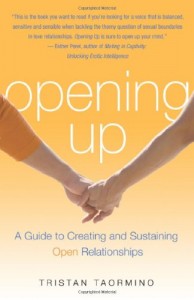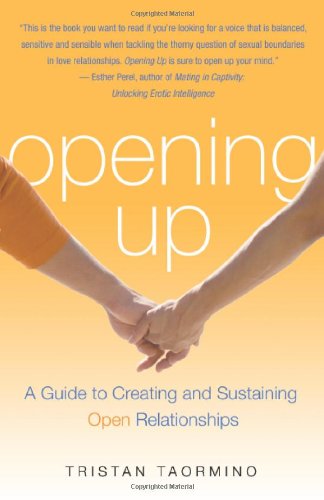Welcome to the first installment of my read-along of Opening Up, by Tristan Taormino.

Previously, this blog hosted a read-along of The Ethical Slut. As with my first series, roughly each week we’ll take a new section of the book and discuss it here. I’ll talk a little about the contents of the chapter and my thoughts on it, then use that to branch off into a general discussion of related topics in non-monogamous relationships. I urge all my readers to join in — you can read the book along with me, but even if you do not I hope the entries will be interesting enough to comment on with your experiences.
I selected this book for my second read-along because it consistently came up when I discussed The Ethical Slut. I was familiar with it before, but it surprised me how everyone wanted me to talk about it. Many people told me they felt like the Ethical Slut was a classic introduction to the field, and the first book on the topic many read, Opening Up by contrast has more details on how to make it work. This is my first reading of the book.
The author is Tristan Taormino, a noted sex educator. She first came to the attention of many (including myself) through her 1997 book The Ultimate Guide to Anal Sex for Women. Just as many people had their first exposure to non-monogamy through the Ethical Slut, I think its true to say that in the 15 years since it was first published, it’s helped many people of all genders have learned not only how to have safe anal sex but how to have anal sex which is pleasurable for everyone involved. Since then she has distinguished herself as a writer, editor, and feminist pornographer. That last profession landed her on my Top Sex Stories of 2011, when Oregon State University uninvited her from giving a keynote address at their sex conference, under the specious rationale that a porn director and actor could not also be a sex educator.
Published in 2008, Opening Up has had just 4 years to become so respected in the field. Taormino based the book on over a decade of research, including many intensive interviews as well as her personal experiences. Her goal was to cut through the façade which surrounds many discussions of non-monogamous relationships. Proponents often try to paint an artificially rosy picture of how easy it is, or make problems sound unrealistically simple to solve.
In keeping with the goals of this book, throughout this read-along I will try to be as honest as possible without spreading any dirt. I will share my successes and failures, the joys and pains of my polyamorous lifestyle. You can find some general background on my experiences with non-monogamy in the background entry from the last read-along. In brief, I have many years of experience with polyamory. I am now in an open relationship with two women, Pet & Honey. Pet and I are entering our third year together, whereas Honey & I celebrated our first anniversary this past Christmas. Though they are friendly and care deeply for each other, they do not date. All of us are free to see other people as long as we maintain open communication and practice safer sex. Both live here in Austin, with Honey currently living with me on a temporary basis. I have a few other more geographically distant or infrequent intimate connections. Honey sees other people, but Pet has remained emotionally though not always sexually monogamous during our relationship.
“It is more common that people are monogamous not by choice but by default; they believe monogamy is what everyone else is doing, what is expected and how relationships are supposed to be.” -from the introduction to Opening Up
In addition to talking about her background and the creation of the book, the introduction to Opening Up takes a look at the state of relationships in our culture today. Most of us grow up believing that lifelong monogamous marriage is not only the current default, but always has been for everyone. Puncturing this myth is one of the main aims of Sex At Dawn, but the opening of this book also looks at the topic in brief. The “nuclear marriage” that conservatives still love to celebrate actually enjoyed only a moment of popularity, propped up by the conservative post-war culture of 1950s America. Countless events (the Stonewall riots), technological developments (birth control), and cultural changes have shown that there is no normal relationship and a lifetime of emotional & sexual monogamy is a rarity and not always a worthwhile or realistic goal.

All relationship styles practiced by humans attempt to answer some basic questions, like ‘how do I create stability and security for myself and my partner(s) in the face of our natural interest in more than one person?’ Traditional Western monogamy attempts to approach this one way, by absolutely forbidding outside liaisons with others while creating what Taormino calls the “shadow institution” of adultery and cheating. It is not the only way.
It’s been a little strange writing this today, since the US news is plastered with reports that Republican Presidential Candidate Newt Gingrich asked a former wife to open their relationship so he could keep a mistress. Non-monogamy isn’t a band-aid to fix a broken relationship, or something to enter by holding an ultimatum over another person’s head. It can be a responsible, ethical relationship style that just happens to be different from the one depicted in most media, and taught to most of us since birth.
Pet commented today how the mainstream media likes to show a certain kind of person when they profile open relationships — long-haired, hippie Renaissance Faire attendees. While I’ve known, loved, and made love to many such people, they don’t accurately depict the diverse people from all backgrounds who choose to look for personal happiness outside of serial monogamy.
Opening Up attempts to cover a wide gamut of relationship styles, from polyamory of many kinds, to swinging, to pairings where one person is monogamous and the other poly. It has chapters devoted to major issues which confront us as we explore these new relationship styles, and profiles of how others have shaped their relationships. Remember as we go through this book that, quoting the author, “there is no formula for an open relationship.” There is not even one definition of polyamory. Instead, approach your relationships as you would a toolbox — choose from what works for you and your lovers, without worrying about what you perceive as normal.
On January 26, 2012 we will return to this read-along with a discussion of Chapter 1, “Pilots, Parties, and Polyamory: A Brief History” which looks at a history of non-monogamy since the 1950s. Until then, introduce yourself here — talk about why you’re interested in this read-along, and share a bit of your background with relationships and non-monogamy. This site welcomes all comments, even anonymous ones.
